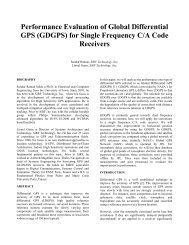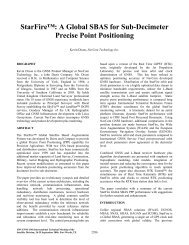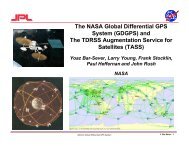Real-time kinematic positioning with NASA's Internet-based ... - gdgps
Real-time kinematic positioning with NASA's Internet-based ... - gdgps
Real-time kinematic positioning with NASA's Internet-based ... - gdgps
Create successful ePaper yourself
Turn your PDF publications into a flip-book with our unique Google optimized e-Paper software.
In the field 99.05% of the messages were received <strong>with</strong> the expected interval of 1 second, only a few<br />
interruptions occurred <strong>with</strong> a maximum of 18 missing messages. In total 106 messages, out of 13008 (logged<br />
over a more than three and a half hour period), went missing. Using the Linux PC in the office, <strong>with</strong> a direct<br />
<strong>Internet</strong> access, availability reached up to 99.97%.<br />
The latency of the corrections on the PC in the office was generally between 6 and 7 seconds. In the field, using<br />
the mobile data communication, the latency was 1 second larger, and generally between 7 and 8 seconds. Only<br />
incidentally, the latency reached up to 11 seconds in the field, see figure 6. These latencies are considered to be<br />
insignificant, because the satellite position corrections are transmitted at a one satellite per one second message<br />
rate, in cycles of 28 seconds. Therefore, the IGDG corrections performance is promising for real-<strong>time</strong> <strong>kinematic</strong><br />
applications. It is to be noted here that the use of the corrections in real-<strong>time</strong> requires GPS clock extrapolation to<br />
an epoch of interest. According to [6], clock extrapolation error for latencies of less than 6 seconds is under 1<br />
cm.<br />
Figure 5: Position coordinate corrections for<br />
SVN32, in meters, over the first 6 hours of the<br />
static test period. The horizontal axis gives the day<br />
since the start of GPS week 1192.<br />
Figure 6: The latency (in seconds) as a function of<br />
<strong>time</strong> for the corrections logged both in office<br />
(green) and in the field (blue) during the <strong>kinematic</strong><br />
test.<br />
Quality assessment of IGDG corrections<br />
We compared JPL’s 15-min <strong>Real</strong>-Time orbits/clocks solutions, which are available from a JPL’s ftp server [14],<br />
<strong>with</strong> the GPS broadcast orbits and clocks improved <strong>with</strong> IGDG corrections. The purpose was to assess the<br />
capability of IGDG corrective information to improve the accuracy of the broadcast orbits and clocks to the<br />
decimeter level. We used GPS data as well as the IGDG corrections logged during the static test and the JPL<br />
<strong>Real</strong>-Time orbits and clocks. Because the GPS broadcast elements provide the coordinates of the satellite’s<br />
antenna phase center and in order to simplify the comparison procedure we used the antenna phase center as a<br />
reference point. The sampling interval was 5 min (the sampling interval of JPL <strong>Real</strong>-Time orbits/clocks<br />
solutions). ITRF2000 was used as a reference frame for comparison.<br />
Figures 7 and 8 show typical results of the comparison for GPS satellites of Block IIA/IIR types. The IGDG<br />
corrections appeared to be able to improve the GPS broadcast satellite orbits and clocks to a decimeter accuracy<br />
level. The improved GPS broadcast ephemerides behave smoothly and are not subject to significant variations<br />
and trends.<br />
The differences between the broadcast GPS ephemerides improved <strong>with</strong> IGDG corrections and JPL <strong>Real</strong>-Time<br />
orbits/clocks solutions were typically about 5-10 cm for orbits and about 15-25 cm for clocks. The<br />
corresponding empirical standard deviations were at the cm level. Although the IGDG corrections are being<br />
formed at JPL as differences between real-<strong>time</strong> dynamic orbits and clocks, and GPS broadcast ephemerides, the<br />
differences <strong>with</strong> JPL’s real-<strong>time</strong> orbits/clocks solutions not equal to zero, as one might expect. This is due to the<br />
fact that the IGDG corrections that were used and the JPL real-<strong>time</strong> products came from two different processes.<br />
The accuracy of JPL real-<strong>time</strong> orbits is about 20 cm [15] what is in a good agreement <strong>with</strong> our results.





